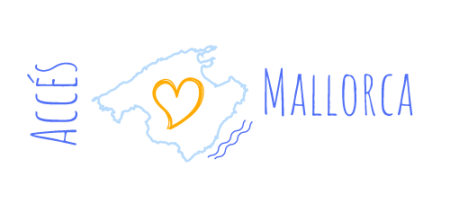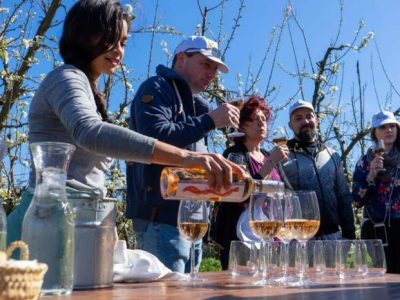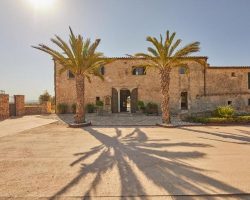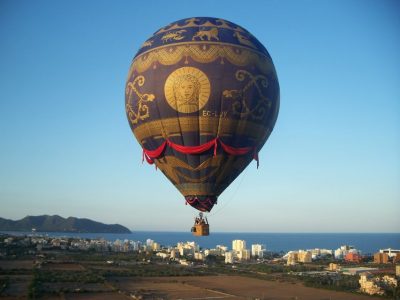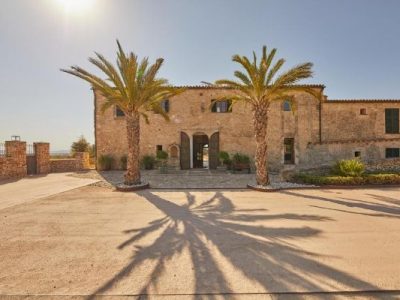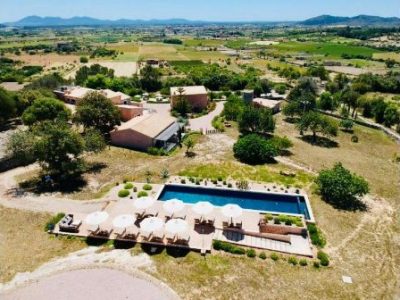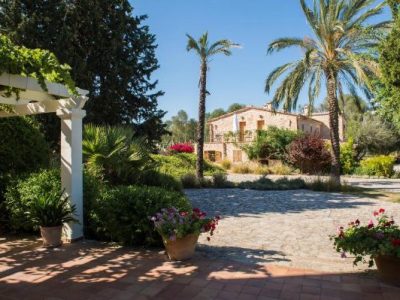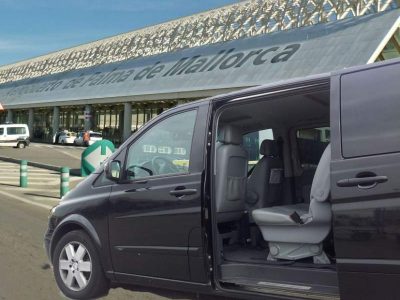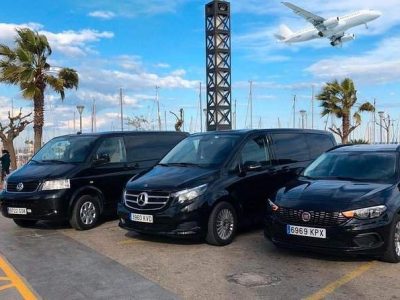Porreres, Mallorca, Things to do and see, hotels, market
Porreres is a typical Mallorcan village located in the rural region of es Pla de Mallorca.
The area around Porreres consists of pastoral idyll, adorned with ancient monasteries, churches, mills and fincas, which help to define the unique local culture here.
Porreres has over the past decade become quite popular amongst prized chefs from the island, who has started a handful of eateries in the area worth visiting.
There are also plenty of things to do in Porreres, i.e. visit some of the many landmarks and oratories in and outside the village.
- This is where I want to go!

Why visit Porreres
Things to do in Porreres
VISIT THE ORATORY OF MONTI-SION
One of the overall attractions in Porreres, is the oratory and former grammar school of Monti-Sion. The sanctuary is beautifully situated at the summit of the homonymous hill just outside the village. From up here, you can adore this historical building with its many beautiful details and breathtaking views over the tranquil landscape.
VISIT THE PAROCHIAL CHURCH OF PORRERES
The parochial church of Porreres is known as “cathedral of rural Mallorca” due to its amazing artworks, architectural finesse and imposing dimensions. The churches are always a sight in Mallorcan villages, and Església de Nuestra Señora de la Consolacion is certainly no exception.
ORATORY OF SANTA CREU
A visit to the oratory of Santa Creu in the roundabout outside the village is always with ambivalent feelings, it is a place that represents both life and death. On one hand, the oratory stands as a monument of miraculous events during the Middle Ages. On the other hand, the oratory, and especially the backdoor and the memorial plate outside, marks the sad happenings of the hundreds of executions done here during the Spanish Civil War.
VISIT THE LOCAL ART MUSEUM OF PORRERES
The local art museum of Porreres is located in the old hospital building of the village, and features a collection of more than 300 works. Since 1982, the collection has been expanded each year due to generous gifts from artists and organizations, which was the main reason for moving the museum from its former location in the town hall to its current. The exhibitions features artworks of all kinds; sculptures, ceramics, paintings etc., from both national and international artists such as Cándido Ballester, Dionís Bennàssar, Jim Bird, Remigia Caubet, Coll Bardolet, Dalí, Macedowski, Pilar Montaner de Sureda, Pere Pujol, Riera Ferrari and Tarrassó.
ORATORY OF SANT FELIP NERI
This impressive church was inaugurated back in 1911, after the fathers of Sant Felip Neri of Palma had arrived in Porreres in 1886. Inside, there are some beautiful artworks to enjoy, among these, the main altarpiece and works garnishing the presbytery along with the golden temple made by sculptor, Vadell.
THE OLD CATHOLIC CENTER
The old Catholic cultural center of Porreres was built to host various activities and performances in order to raise money for the church. Today, it serves as a great local restaurant where you can get a delicious menu del día for almost no money.
RECTORY OF PORRERES
The rectory is located across the street from the parochial church. It features a stunning and curious building facade made of semi-circular arches, columns and a relief of Sant Francesc.
DISCOVER THE OLD WINDMILLS
Within the municipality borders, more than 36 mill towers stand as icons of one of the most wealthy periods in Porreres. While most of the old mills are scattered in the area surrounding the village, 10 of them are found in the urban nucleus, easy to find and admire. The mills all come in different shapes and state of condition, some are used as warehouses, other belong to domestic properties and some has been completely abandoned.
FAQ
Porreres has a great variety of rural hotels, agroturismos and fincas for you to choose from.
Here are the best accommodation options in Porreres:
Porreres is located approx. 35 km (~22 miles) from Palma airport. The transfer time by car or taxi is about 25 minutes.
A taxi from the airport will cost about 40-45 euros.
If you prefer a more comfortable transfer, consider an air-conditioned private minibus. Book here
Every Tuesday morning, the weekly market in Porreres is held from around 8 am.
Due to its great location, you can choose from a wide selection of great beaches, all within 30 minute drive from Porreres. Some of them include the wide Arenal beach, the natural es Trenc beach, the cove of Cala Pi or the Blue Flag beaches in Colònia de Sant Jordi.
Market and Events in Porreres
Weekly market
The weekly market in Porreres is held on Tuesdays starting from around 8 in the morning. The market is a great opportunity to sample some of the local products of Porreres, especially wine, fruits and cheeses.
Events and festivities in Porreres
January
Sant Antoni
Sant Antoni (Saint Anthony) is celebrated with bonfires and food all over the town. Different bars, restaurants and associations lights bonfires to mark the day of Sant Antoni. Typically, there is also dances and music in the streets.
February
Sa Rua (Carnival)
On Saturday of Carnival, come and experience the many costumes and parades going through town accompanied by music and dancing. On Tuesday, the ritual of “Cataracta Mundi” happens. It is a procession which includes a burial of a doll that symbolizes the Carnival. After this ritual, sardines are served according to tradition.
Fira d’oportunitats
The first of two sales fairs are held in February, the other in September. It is the association of merchants and traders in Porreres that has taken initiative to this great fair where all local shops sells their stock at very discounted prices.
April
Domingo del Ángel, Pancarity in Monti-sion
The first Sunday after Easter is known as “Angel Sunday”, which is celebrated with a huge party at the Monti-Sion. The entire town walks to the sanctuary where there are acts and dances to enjoy. This is also the time for the traditional “Pancaritat”, where all leftover bread from Easter is served. In our times, however, it is freshly baked pastries.
Eco-day
To celebrate the arrival of the first good days of spring, the town hosts a fair dedicated to ecological products. Here, you can browse and sample a wide variety of local ecological products, a great day to find inspiration.
May
Fira Musical
On the third Sunday of May, the town of Porreres is dedicated to music and everything related to this topic. Come enjoy a variety of exhibitions, sales, and most of all, performances.
August
Festes de Sant Roc
Sant Roc is the patron saint of Porreres and celebrated on August 16th. The festivities lasts for 8 days during which you can enjoy a range of fun activities like parades, competitions, dances, religious acts. There will also be served traditional pies. During these festivities, Porreres hosts some of the most renown concerts in the park of n’Hereveta.
September
Fira d’oportunitats
The second edition of the sales fair during the year is held in September. To celebrate the end of the season, come find the best deals on shoes, clothes, jewelry, local products and much more.
October
Fira de Tardor
Fira de Tardor is the autumn fair which is held on the first Sunday after St. Luke’s (October 18) and on the first Sunday of November. This autumn fair has become one of the most popular of its kind in Mallorca over the recent years, and continues to grow each year. Come enjoy a festive day with autumn market, crafts, arts, animals, games, agricultural machinery, vehicles and lots of food. On the Friday before the Sunday, there is a great wine tasting event in the mill of n’Amengual de Porreres. The autumn fair is also a great day to discover select specialties of Porreres created by the bars and restaurants of the town.
November
Mitja Marató & 10 Kms
On the second weekend of November, Porreres hosts a half marathon. Actually, it is a half marathon plus 10 km. There is usually more than 500 participants attending this fun sports event.
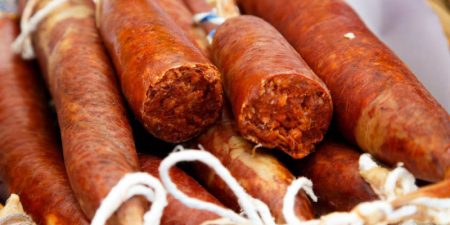
Support Local
Supporting local communities during your travels can have a profound impact. Stock up with groceries locally, stop in an artisan shop or enjoy a refreshment at a restaurant or bar. Now more than ever, these small businesses need support from travelers near and far.
Get to know the area of Porreres
About the area of Porreres
Porreres is a town and municipality located in the most southern part of the Pla de Mallorca region. The municipality comprises 8,684 hectares of land with a population of 5,339 inhabitants as of 2018, and borders the municipalities of Muntuïri, Llucmajor, Campos, Felanitx, Sant Joan and Vilafranca de Bonany.
The inhabitants identifies as “porrerencs” and “porrerenques”, men and women, respectively. As with most other Mallorca villages, unity bonds the inhabitants in a strong spirit that is felt when passing in the streets of the village. Also, the many fairs and festivities, eateries and local businesses are evidence of the entrepreneurial spirit and support in the community.
Typical products
Apricots
Wine
History of Porreres
The area of Porreres has been inhabited by humans since ancient times, actually, more than thirty different archaeological sites are cataloged with the municipality borders.
From the rather undefined Pre-Talayotic era about 2,400 BC, several caves used for habitation and funerary purposes has been discovered, one of them is the Cueva D’en Gornals.
From the Talayotic period about 1,100 – 300 BC, the impressive constructions of Beulenes and Es Pagos has been found. Also worth a mention, is the walled enclosure of “Pou Salat” which evidences the Talayotic mind-set of building fortified villages. Lastly, the necropolises of Puig de Son Redó and Puig de la dels Pagos.
Roman presence in the area has been verified by several discoveries done in the 19th century. Two of the most remarkable founds of this period are the funerary tombstones found in the area of Son Cota and a pillar with Latin inscription found in a grave. Exactly when the Roman left Mallorca is uncertain, but it is commonly believed that it must have been sometime around the 5th century AD.
During Muslim dominance between 902 and 1229, the area belonged under a bigger district known as “Juz’ de Manaqur” which also included the current municipalities of Manacor, Felanitx and Ses Salines. The area belonged to the Moorish Berber tribes of Zanata and Humeya, who settles in small huts and farmhouses. Some of these farmhouses are still found in the municipality, or at least their names are preserved. The Moors introduced hydraulic infrastructure to the island in form of water tunnels (qanats) for transporting water and wells for collecting water. The most outstanding examples are the wells of Juà and Dama. Also, Arabic coins minted in Mallorca has been found in the area.
With the Catalan conquest of Mallorca in 1229/32, Mallorca was distributed amongst supporters and participants of the conquest by King Jaume I of Aragón. Moors that wasn’t killed was taken as slaves and sold to new settlers from the mainland. The area of Porreres was given to count Nuno Sanç, but with his death already in 1241, the area passed to King Jaume I.
The name of Porreres came from one of the participating knights; Guillem de Porrera, whom came from the town of Priorat in Tarragona. Guillem de Porrera became the owner of the former Moorish farmhouses of Alquazor, Maffumet and Totzeta.
The new Christian dominance in Mallorca meant that all mosques had to be either transformed or destroyed, and it did not take many years before the first churches and chapels were built. The first documentation of a chapel in Porreres derives from 1242, and again in 1248 a church was described in a bull of Pope Innocence IV. Documents points on the old church of l’Hospitalet to be the first primitive church construction of Porreres. Moreover, in 1879, a major restoration work of this church led to the found of a Gothic altarpiece representing the two patron saints of Sant Joan Baptista and San Joan Evangelista (John the Baptist and Jogn the Evangelist).
During this time and until the year 1300, Porreres belonged under the same district as Campos, Santanyí and Felanitx.
Under the reign of King Jaume II of Mallorca, a period of great societal balance and peace, some fundamental yet very important decisions were made. The most noteworthy politics of this period, was the creation of the Mallorcan monetary system and the enactment of the ordinations in the year 1300. This document, Ordinació de les pobles, very well defined and constituted towns with at least 100 inhabitants. A lot of towns and villages of Mallorca was found already at that time by those ordinations, including Porreres. Some of the other towns founded here, includes Artà, Capdepera, Montuïri, Sant Joan, Petra, Felanitx, Campos and Manacor.
During the 14th and 15th centuries, the urban nucleus of Porreres grew, new streets were opened and new neighborhoods arose. During this time, a Jewish community also settled in Porreres.
From the late 14th century, a societal conflicts started to evolve between small farmers and the nobility of the island. Between 1391 and 1523, two major conflicts marked the history of Mallorca and the local community of Porreres, the Revolta Forana and later the rise of the Germanies. Both conflicts had major impact on the local economy and population, as lives were lost and severe damages left the town in massive depth.
In 1498, the oratory of Our Lady of Monti-Sion was erected at the summit of the hill of same name, in 245 meters altitude. In the beginning of the 16th century, a grammar school is inaugurated here with the purpose of preparing pupils for general studies and achieve higher education. Documents claims that there was about 200 pupils in 1680.
During the War of Succession (1702 – 1715), Porreres fought in favor of Archduke Charles of Austria, even though there was a small group of supporters of Felipe V (botiflers). With the victory of the Bourbon power, all municipal governance was essentially removed and replaces by decrees from the central power, meaning that only administrative and smaller urban affairs was handled in the town councils. Moreover, mayors were appointed by the military. In Porreres, also the grammar school was closed and only Castilian language could be taught.
The 19th century brought yet another series of turbulent years to Porreres, again caused by conflicts in regards to the Spanish crown. First, the First Carlist War, and later, the Glorious Revolution. During the First Carlist War (1833-1840), in 1836, the Prime Minister of Spain at that time, Juan Álvarez Mendizábal, confiscated all monastic properties of Spain, including the Monti-Sion and 53 other properties in Porreres, and auctioned them to private investors in order to raise money to support Maria Christina and Isabell II. This was known as “La desamortización eclesiástica de Mendizábal“. Later, in 1868 during the Glorious Revolution, more than 50 people from Porreres participated in fights and vandalism causing the municipal document files to be lost in the fires.
In the first quater of the 20th century there were about 5,000 inhabitants in Porreres. The number varied a lot during this time due to pandemics such as the Spanish Flu in 1918, and the big emigration to South America due to the pylloxera (wine lice) causing many fields to be burnt to the ground.
During the Second Spanish Republic (1931-1939), the first mayor of Porreres was democratically elected, this was Joan Mora Ferrando whom represented the regionalist party. Also during the Second Spanish Republish, several unions were founded for workers in Porreres, the football (soccer) club of US Porreres was founded, the Instructional Center and the public school were founded and the municipal library was opened. Moreover, the Plaça de la República (currently Plaça de la Vila) and several other areas of the town underwent major improvements.
When the Spanish Civil War broke out in July 1936, more than 30 inhabitants of Porreres were shot, among these the mayor and the entire town council. The executions of people happened inside the walls of the Santa Cruz oratory. Prisoners from other prisons like Can Mir, Can Sales and Castell de Bellver, was also brought here for execution. The Franco regime banned all unions, Mallorcan flags, political parties, teaching of the Catalan language etc. First in 1979, a democratically elected mayor was reinstated – Francesc Sastre Mora.
Practical Info
Useful Numbers
Emergency: 112
National police: 091
Local police: 092
Guarda civil: 062
Fire: 080
Maritime emergencies: 900 202 202
Town Hall: +34 971 64 72 21
Public Transport
Bus lines: 403, 417
Power Supply
220V
